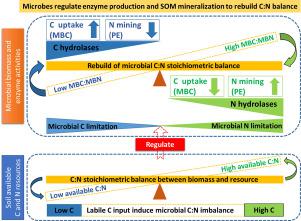Applied Soil Ecology ( IF 4.8 ) Pub Date : 2021-04-21 , DOI: 10.1016/j.apsoil.2021.104033 Zhenke Zhu , Juan Zhou , Muhammad Shahbaz , Haiming Tang , Shoulong Liu , Wenju Zhang , Hongzhao Yuan , Ping Zhou , Hattan Alharbi , Jinshui Wu , Yakov Kuzyakov , Tida Ge

|
Labile carbon (C) inputs affect the soil carbon:nitrogen (C:N) ratio and microbial stoichiometric homeostasis, which control the intensity and direction of the priming effect (PE). Here, we clarified how soil microorganisms regulate enzyme production and PE to maintain the C:N stoichiometric balance. Specifically, we conducted an incubation experiment by adding 13C-labeled glucose to four long-term fertilized paddy soils: no fertilization; fertilization with mineral nitrogen, phosphorus, and potassium (NPK); NPK combined with straw; and NPK with manure (NPKM). After glucose addition, the dissolved organic carbon-to-ammonium (DOC:NH4+) ratio (24–39) initially increased, but subsequently decreased after day 2 following glucose exhaustion. In parallel, the microbial C:N imbalance [(DOC:NH4+):(microbial biomass C:microbial biomass N)] rapidly decreased from day 2 (4.6–7.2) to day 20 (<0.5). Thus, microorganisms became C limited after 20 days of incubation. Excess C, resulting from glucose addition, increased N-hydrolase (chitinase) production and N mining from soil organic matter (SOM) through positive PEs. However, C hydrolase (β-1,4-glucosidase and β-xylosidase) activity increased, while that of N hydrolase (chitinase) decreased, following glucose exhaustion. Consequently, the C:N microbial biomass ratio increased as the DOC:NH4+ ratio decreased, leading to negative PEs. NPKM-fertilized soil had the largest cumulative PE (2.3% of soil organic carbon) because it had the highest microbial biomass and iron (Fe) reduction rate. Thus, this increased N mining from SOM maintained the microbial C:N stoichiometric balance. We concluded that soil microorganisms regulate C- and N-hydrolase production to control the intensity and direction of PE, maintaining the C:N stoichiometric balance in response to labile C inputs.
中文翻译:

微生物通过调节长期施肥土壤中的启动效应来维持C:N的化学计量平衡
不稳定碳(C)的输入会影响土壤碳:氮(C:N)的比例和微生物化学计量的稳态,从而控制启动效应(PE)的强度和方向。在这里,我们阐明了土壤微生物如何调节酶的产生和PE以维持C:N的化学计量平衡。具体而言,我们通过向4种长期施肥的水稻土中添加13 C标记的葡萄糖进行了温育实验:用矿质氮,磷和钾(NPK)施肥;氮磷钾配秸秆; 和NPK肥料(NPKM)。添加葡萄糖后,溶解的有机碳-铵(DOC:NH 4 +)比率(24-39)开始上升,但在葡萄糖耗尽后的第2天之后下降。同时,微生物C:N不平衡[(DOC:NH 4 +):(微生物生物量C:微生物生物量N)]从第2天(4.6-7.2)到第20天迅速减少(<0.5)。因此,温育20天后微生物变得C受限。葡萄糖添加导致的过量碳,增加了N-水解酶(几丁质酶)的产生以及通过阳性PE从土壤有机质(SOM)开采的氮。然而,葡萄糖耗尽后,C水解酶(β -1,4-葡萄糖苷酶和β-木糖苷酶)的活性增加,而N水解酶(几丁质酶)的活性降低。因此,随着DOC:NH 4 +的增加,C:N微生物的生物量比增加。比率下降,导致PE变为负数。NPKM施肥的土壤具有最大的累积PE(占土壤有机碳的2.3%),因为它具有最高的微生物生物量和铁(Fe)还原率。因此,从SOM开采的增加的N含量保持了微生物C:N化学计量的平衡。我们得出结论,土壤微生物调节C和N水解酶的产生,以控制PE的强度和方向,响应不稳定的C输入,保持C:N的化学计量平衡。



























 京公网安备 11010802027423号
京公网安备 11010802027423号